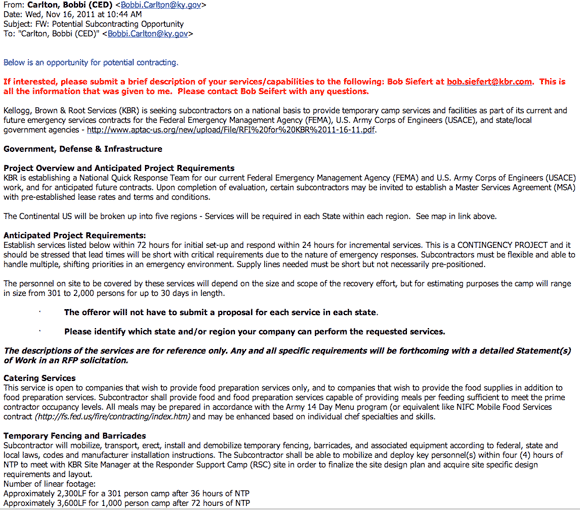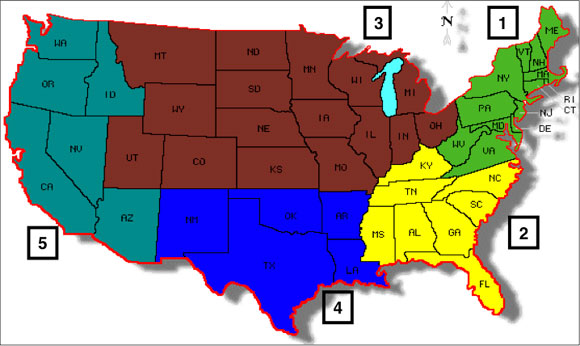Infowars.com
December 6, 2011
Infowars.com has received a document originating from Halliburton subsidiary KBR that provides details on a push to outfit FEMA and U.S. Army camps around the United States. Entitled “Project Overview and Anticipated Project Requirements,” the document describes services KBR is looking to farm out to subcontractors. The document was passed on to us by a state government employee who wishes to remain anonymous for obvious reasons.

Services up for bid include catering, temporary fencing and barricades, laundry and medical services, power generation, refuse collection, and other services required for temporary “emergency environment” camps located in five regions of the United States.
Internment Camp Services Bid Arrives After NDAA
KBR’s call for FEMA camp service bids arrives soon after the Senate overwhelmingly passed the National Defense Authorization Act (NDAA) which permits the military to detain and interrogate supposed domestic terror suspects in violation of the Fourth Amendment and Posse Comitatus.
Section 1031 of the NDAA bill declares the whole of the United States as a “battlefield” and allows American citizens to be arrested on U.S. soil and incarcerated in Guantanamo Bay.
A number of civil liberties groups have come out in strong opposition to the legislation, most notably the Japanese American Citizens League (JACL), the nation’s oldest and largest Asian American civil and human rights organization.
In a letter addressed to Congress, S. Floyd Mori, the national director of JACL, said the NDAA is the first time that Congress has scaled back on the protections provided by the Non-Detention Act of 1971. Mori said the legislation, if enacted and put into use, would be reminiscent of the unconstitutional indefinite detention of Japanese Americans during World War II.
Police State 4: The Rise of FEMA.
KBR Instrumental in Establishing Camps in 2006
In 2006, KBR was awarded a contingency contract from the Department of Homeland Security, allegedly to support its Immigration and Customs Enforcement facilities in the event of an emergency, Market Watch reported.
The contract was effective immediately and provided for establishing temporary detention and processing capabilities to expand existing ICE Detention and Removal Operations Program facilities in the event of an emergency influx of immigrants into the U.S., or to support the rapid development of new programs, KBR said. The contract may also provide migrant detention support to other government organizations in the event of an immigration emergency, as well as the development of a plan to react to a national emergency, such as a natural disaster, the company explained.
 The regions indicated in the KBR document.
The regions indicated in the KBR document.Army Releases Civilian Inmate Labor Program Document
Soon after KBR’s announcement, a little-known Army document surfaced. Entitled the “Civilian Inmate Labor Program,” the unclassified document describes in detail Army Regulation 210-35. The regulation, first drafted in 1997, underwent a “rapid act revision” in January 2005 and now provides a policy for the creation of labor programs and prison camps on Army installations.
National Emergency Centers Act
In 2009, the National Emergency Centers Act or HR 645 was introduced in Congress. It mandates the establishment of “national emergency centers” to be located on military installations for the purpose of providing “temporary housing, medical, and humanitarian assistance to individuals and families dislocated due to an emergency or major disaster,” according to the bill.
In addition to emergencies, the legislation is designed to “meet other appropriate needs, as determined by the Secretary of Homeland Security,” an open ended mandate which many fear could mean the forced detention of American citizens in the event of widespread rioting after a national emergency or total economic collapse, as Paul Joseph Watson noted in January of 2009.
See videos at infowars.com

No comments:
Post a Comment